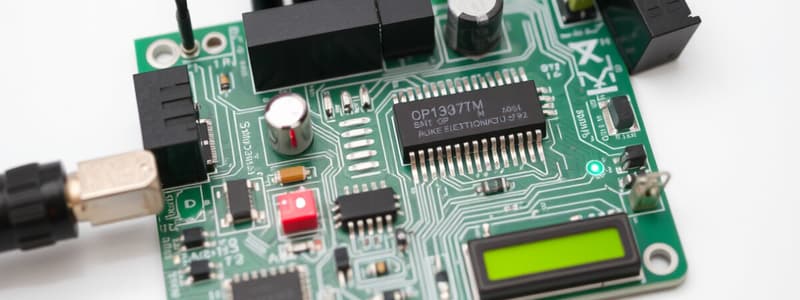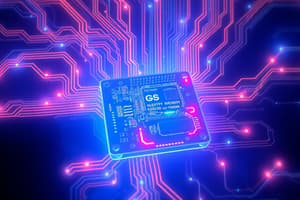Podcast
Questions and Answers
What characterizes Direct Current (DC)?
What characterizes Direct Current (DC)?
- It has a power supply frequency of 60 Hz.
- Measured in Hertz (Hz).
- Electricity flow direction reverses repeatedly.
- Electricity flows in one direction. (correct)
In a series circuit, how does the voltage behave?
In a series circuit, how does the voltage behave?
- There is no voltage drop across the components.
- Voltage is divided among the components. (correct)
- The total voltage is always higher than the source.
- All components receive the same voltage.
What is the primary function of a capacitor in a circuit?
What is the primary function of a capacitor in a circuit?
- To store and discharge electricity. (correct)
- To convert AC to DC current.
- To amplify the voltage to higher levels.
- To provide resistance and limit current flow.
What unit is used to measure resistance in an electrical component?
What unit is used to measure resistance in an electrical component?
What does a diode do in an electrical circuit?
What does a diode do in an electrical circuit?
What is the function of a transistor?
What is the function of a transistor?
What is a key feature of integrated circuits (ICs)?
What is a key feature of integrated circuits (ICs)?
In which configuration should multiple LEDs be wired for optimal performance?
In which configuration should multiple LEDs be wired for optimal performance?
What characteristic distinguishes potentiometers from other resistors?
What characteristic distinguishes potentiometers from other resistors?
How do batteries behave when connected in series?
How do batteries behave when connected in series?
Flashcards are hidden until you start studying
Study Notes
Overview of Basic Electronics
- Basic electronics can be learned without deep diving into electrical engineering.
- Goal: Understand schematics and building circuits with standard components.
Types of Electrical Signals
- Two main types of electrical signals: Alternating Current (AC) and Direct Current (DC).
- AC: Electricity flow direction reverses repeatedly; measured in Hertz (Hz).
- US power supply frequency is 60 Hz, meaning 120 reversals per second.
- DC: Electricity flows in one direction from power to ground, with a positive voltage source.
Fundamental Electrical Concepts
- Electricity is defined by voltage (Volts) and current (Amps).
- Example: A new 9V battery has a voltage of 9V and a current of around 500mA.
- Resistance (Ohms) and wattage are also key concepts; wattage is calculated as voltage x current.
Understanding Circuits
- A circuit is a closed path that allows electrical current to flow.
- Closed circuits enable current flow; open circuits break this flow.
Circuit Configurations
- Series configuration: Same current flows through all components; voltage divides.
- Parallel configuration: All components receive the same voltage; current divides.
Resistors
- Resistors add resistance, reducing current flow. Represented in diagrams as a zigzag line.
- Resistance values measured in Ohms (Ω) and wattage ratings; commonly use ¼ watt for low-voltage DC circuits.
- Resistor color codes indicate resistance value and tolerance and can be converted into KΩ and MΩ.
Capacitors
- Capacitors store and discharge electricity to maintain a steady current; akin to a water storage tank.
- Measured in Farads (F), commonly in picofarads (pF), nanofarads (nF), and microfarads (µF).
- Electrolytic capacitors are polarized; connection must follow correct polarity for function.
Diodes
- Diodes control the direction of current flow; only permit passage in one direction.
- Represented in circuits as a line and triangle shape, with voltage drop of about 0.7V.
Transistors
- Transistors amplify current from a small input to a larger output; categorized into NPN and PNP types.
- NPN allows current from collector to emitter; PNP does the opposite.
- Ensure to check voltage and current ratings when using transistors.
Integrated Circuits (IC)
- ICs consolidate an entire circuit onto a single chip, combining multiple components.
- Understanding pin functionalities and properties is essential; datasheets provide this information.
Potentiometers
- Potentiometers act as variable resistors, adjusting resistance through a knob or slider.
- Commonly found in volume knobs and light dimmer controls.
Light Emitting Diodes (LEDs)
- LEDs are special diodes that glow when current passes; also polarized.
- Require an appropriate resistor in series to avoid circuit shorting; best wired in parallel for multiple LEDs.
Switches
- Switches open or close circuits, controlling electricity flow; can be normally open or normally closed.
Batteries
- Convert chemical energy into electrical power; voltage adds in series, while current doubles in parallel.
Breadboards
- Used for prototyping; they have a grid of electrically connected holes to build circuits without soldering.
- Includes power and ground bus lines for easy access; jumper cables are ideal for connections.
Practical Application
- Building a basic LED circuit with a resistor and switch demonstrates turning the LED on/off.
- Understanding component connections is crucial for successful circuit assembly.
Conclusion
- Additional resources and channels are available for further learning in basic electronics.
- Viewer engagement is encouraged for sharing tips and experiences.
Overview of Basic Electronics
- Basic electronics can be acquired without an extensive background in electrical engineering.
- The primary goal is to grasp schematics and construct circuits using standard components.
Types of Electrical Signals
- There are two primary electrical signal types: Alternating Current (AC) and Direct Current (DC).
- AC: The direction of electricity flow alternates; frequency is measured in Hertz (Hz).
- In the U.S., the power supply operates at 60 Hz, resulting in 120 reversals of current per second.
- DC: Electricity flows in one direction, from a positive voltage source to ground.
Fundamental Electrical Concepts
- Voltage is measured in Volts (V), while current is measured in Amperes (A).
- A typical 9V battery delivers approximately 500mA of current.
- Resistance is measured in Ohms (Ω) and wattage is calculated as voltage multiplied by current.
Understanding Circuits
- A circuit is a closed loop that enables electrical current to flow.
- Closed circuits allow current flow; open circuits break this continuity.
Circuit Configurations
- In a series configuration, the same current passes through all components, causing voltage to divide.
- In a parallel configuration, all components receive the same voltage, resulting in current division.
Resistors
- Resistors introduce resistance, which reduces current flow, depicted as a zigzag line in circuit diagrams.
- Resistance values are denoted in Ohms (Ω) with typical wattage ratings of ¼ watt for low-voltage DC circuits.
- Color codes on resistors indicate resistance value and tolerance, extendable into kilo-ohms (KΩ) and mega-ohms (MΩ).
Capacitors
- Capacitors store and release electricity, stabilizing current flow; analogous to a water tank.
- Capacitance values are measured in Farads (F), typically represented in picofarads (pF), nanofarads (nF), and microfarads (µF).
- Electrolytic capacitors are polarized; correct polarity is crucial for operation.
Diodes
- Diodes regulate current flow, allowing passage in one direction only.
- They are illustrated in circuits by a line and triangle symbol, with a standard voltage drop of approximately 0.7V.
Transistors
- Transistors are used to amplify current from a smaller input to a larger output, classified into NPN and PNP types.
- In NPN transistors, current flows from the collector to the emitter, while in PNP, the flow is reversed.
- Voltage and current ratings must be checked when employing transistors.
Integrated Circuits (IC)
- ICs integrate an entire circuit onto a single semiconductor chip, merging various components.
- Understanding the functionality of pins is essential, with datasheets providing necessary specifications.
Potentiometers
- Potentiometers function as variable resistors, allowing resistance adjustment via a knob or slider.
- Common applications include volume controls and light dimmers.
Light Emitting Diodes (LEDs)
- LEDs are distinctive diodes that emit light when current passes through; they are also polarized.
- To prevent circuit shorts, a suitable resistor should be connected in series; it is advisable to wire multiple LEDs in parallel.
Switches
- Switches control electricity flow by opening or closing circuits; they can be classified as normally open or normally closed.
Batteries
- Batteries convert chemical energy into electrical energy; voltage adds up when batteries are placed in series, while current doubles in parallel configurations.
Breadboards
- Breadboards facilitate circuit prototyping with a grid of connected holes for assembling components without soldering.
- They feature accessible power and ground bus lines, while jumper cables are useful for making connections.
Practical Application
- Constructing a basic LED circuit with a resistor and switch illustrates the practical use of components in controlling electrical flow.
Conclusion
- A variety of additional resources are available for continued learning in basic electronics.
- Viewer engagement and knowledge sharing are encouraged to enhance learning experiences.
Studying That Suits You
Use AI to generate personalized quizzes and flashcards to suit your learning preferences.




